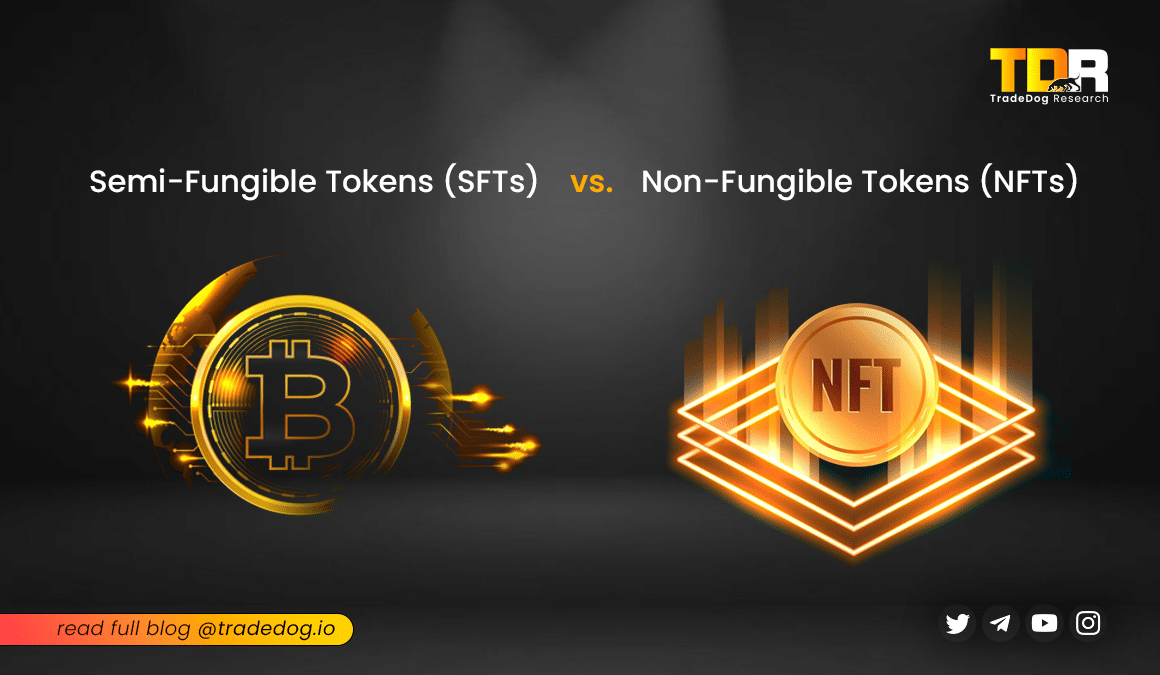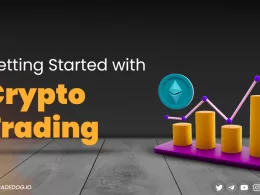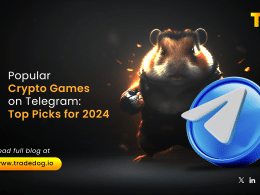Quick Links
Have you ever bought a digital item, like a song or an in-game skin, and wished you truly owned it? What if there was a way to prove you held the original, just like a physical collectible? Blockchain technology, the secure system behind cryptocurrencies, is paving the way for digital ownership through revolutionary tools called NFTs and SFTs. The NFT (Non-Fungible Token) market is booming, with a current market capitalization of ~ $75.09 Bn and is expected to reach ~ $231 Bn with a growth rate (CAGR) of 20.62% by 2030.
Understanding Digital Ownership
Imagine a baseball card collection. Every card is unique (non-fungible), even if they’re from the same set. Now, imagine the same for digital items. Unlike money (fungible – you can trade one dollar for another), NFTs or Non-Fungible Tokens create a digital certificate of ownership for things like artwork, music, or even virtual land. NFTs exploded in popularity recently, with artists selling digital paintings for millions! But while NFTs excel at representing one-of-a-kind items, what about things that can be divided, like a stock or a concert ticket? Here’s where SFTs (Semi-Fungible Tokens) come in.
Non-Fungible Tokens (NFTs)
The concept of NFTs can be traced back to 2012 with the creation of “Colored Coins” on the Bitcoin blockchain. However, the mainstream adoption of NFTs boomed in 2017 with the rise of “CryptoKitties,” a game where players could buy and breed virtual cats represented by NFTs. They act as digital certificates of ownership for unique items, essentially turning them into tradable assets. Imagine a one-of-a-kind digital artwork or a rare in-game item – NFTs allow verifiable ownership of these on a secure digital ledger called the blockchain.
Use Cases
NFTs are finding applications in various industries, here are a few exciting examples:
- Digital Art & Collectibles: NFTs have revolutionized the art world. Artists can now sell their digital creations directly to collectors, ensuring authenticity and scarcity. This extends beyond visual art, encompassing music, video clips, and even memes.
- Gaming: In-game items like weapons, skins, or virtual land can be represented by NFTs, allowing players to own and potentially trade them outside the game. This opens up new possibilities for in-game economies.
- Fashion & Luxury Goods: Leading fashion brands are exploring NFTs to authenticate luxury items and offer exclusive experiences to holders. Imagine owning a digital version of a limited-edition bag!
- Ticketing & Events: NFTs can represent event tickets, offering benefits like proof of attendance, access to exclusive content, or even resale opportunities with built-in royalties for the creator.
- Fashion & Luxury Goods: Leading fashion brands are exploring NFTs to authenticate luxury items and offer exclusive experiences to holders. Imagine owning a digital version of a limited-edition bag that grants access to exclusive events or discounts.
- Identity & Verification: NFTs can be used to store and manage verifiable credentials like diplomas, certificates, or even loyalty points. This ensures authenticity and simplifies the sharing of verified information.
Benefits of NFTs
- Uniqueness & Verifiability: NFTs are one-of-a-kind and their ownership is immutably recorded on the blockchain, eliminating counterfeiting.
- New Revenue Streams: Creators can monetize their work directly and potentially benefit from secondary sales through royalties.
- Enhanced Security: Blockchain technology provides a secure and transparent way to track ownership and prevent fraud.
Challenges & Drawbacks
- Market Volatility: The NFT market is still young and lacks established valuation methods, leading to price fluctuations.
- Environmental Impact: Creating and trading NFTs currently requires significant energy consumption.
- Accessibility & Technical Barriers: Entering the NFT market requires understanding cryptocurrency and navigating sometimes complex platforms
The Rise of SFTs
NFTs (Non-Fungible Tokens) have taken the digital world by storm, offering unique ownership for one-of-a-kind assets. But what if you want to own a piece of something valuable, but not the whole thing? Enter Semi-Fungible Tokens (SFTs), a new player in the digital ownership arena. Unlike NFTs, which are unique, SFTs can be divided into smaller units. This makes them ideal for representing assets that multiple people can share or own.
The concept of SFTs is relatively new, their origins can be traced back to the ongoing development of token standards within the blockchain ecosystem. While blockchain provides the foundation, SFTs often utilize specific token standards within a chosen blockchain platform. A popular option is the ERC-1155 standard on the Ethereum blockchain. This standard defines functionalities specifically suited for creating and managing tokens with varying degrees of fungibility, including NFTs and SFTs.
Use Cases
SFTs hold immense potential to disrupt ownership models across various sectors:
- Fractionalized Real Estate: Imagine co-owning a luxurious vacation property through SFTs. This allows for broader investor participation and easier asset management.
- Supply Chain Tracking: SFTs can be embedded with dynamic data, allowing for real-time tracking of goods throughout the supply chain. This ensures transparency and combats counterfeiting.
- Loyalty Programs: Revolutionize loyalty points by issuing them as SFTs that can be traded or combined for exclusive rewards, offering greater flexibility for customers.
- Event Ticketing: Similar to NFTs, SFTs can represent event tickets. However, with SFTs, partial ownership becomes possible, allowing ticket sharing or even reselling portions of the ticket value.
- Decentralized Finance (DeFi): SFTs can be used to represent fractionalized ownership of real-world assets, such as debt or equity, facilitating innovative DeFi applications.
Benefits of SFTs
- Fractional Ownership: Makes expensive assets more accessible to a wider audience.
- Dynamic Properties: SFTs can be programmed to evolve, reflecting changes in the underlying asset (e.g., property value appreciation).
- Increased Liquidity: SFTs are divisible and tradable in smaller units, enhancing market liquidity.
Challenges & Drawbacks
Regulation: The legal framework surrounding SFTs is still under development, creating uncertainty for businesses and investors.
Technical Complexity: SFTs require more complex programming compared to NFTs, posing a challenge for creators and platforms.
Market Adoption: As a new concept, SFTs require wider adoption by businesses and consumers to reach their full potential.
NFTs vs. SFTs
Both NFTs & SFTs utilize blockchain technology to represent ownership, but are fundamentally different. Here’s a breakdown of their key features:
| Feature | NFTs | SFTs |
| Fungibility | Non-fungible (unique) | Semi-fungible (divisible) |
| Use Cases | Digital art, collectibles, in-game items | Fractionalized ownership of assets, supply chain tracking, loyalty programs |
| Benefits | Uniqueness, new revenue streams, security | Fractional ownership, dynamic properties, liquidity |
| Drawbacks | Market volatility, environmental impact, accessibility | Regulation, technical complexity, market adoption |
| Ownership | Entire asset | Fractionalized ownership (units) |
Well, what’s the Difference?
NFTs are irreplaceable, like a rare trading card. SFTs, on the other hand, can be broken down into smaller units, allowing for shared ownership – like co-owning a digital racehorse. Imagine a one-of-a-kind digital artwork by a famous artist. This would be perfectly represented by an NFT, ensuring its exclusivity and value. Now imagine a luxurious vacation villa in Bali. SFTs would make it possible to co-own this property with friends, dividing the ownership and simplifying management.
Conclusion
The world of digital ownership is undergoing a revolution with the rise of NFTs and SFTs. NFTs empower creators to monetize their work directly and cultivate passionate communities. SFTs, on the other hand, unlock new avenues for investment and asset management by enabling fractional ownership. Across industries, from art and gaming to real estate and supply chains, these technologies have the potential to disrupt traditional models and create more efficient, transparent, and secure systems.
While challenges like market volatility and evolving regulations remain, the potential benefits of NFTs and SFTs are undeniable. As these technologies mature and gain wider adoption, we can expect them to play a transformative role in shaping the future of digital ownership. Imagine a world where artists, musicians, and creators have greater control over their work, where investors can access a wider range of opportunities, and where ownership of digital assets is secure, transparent, and transferable.









